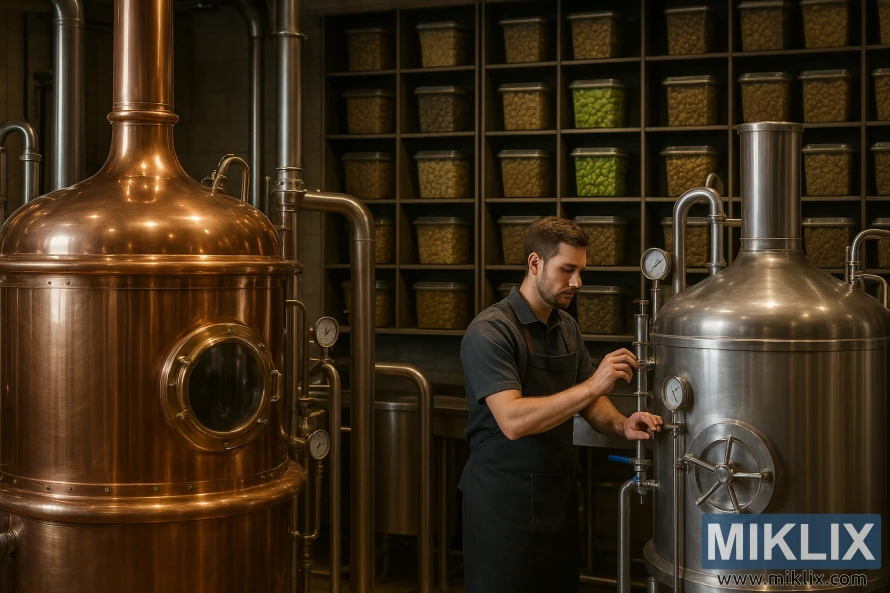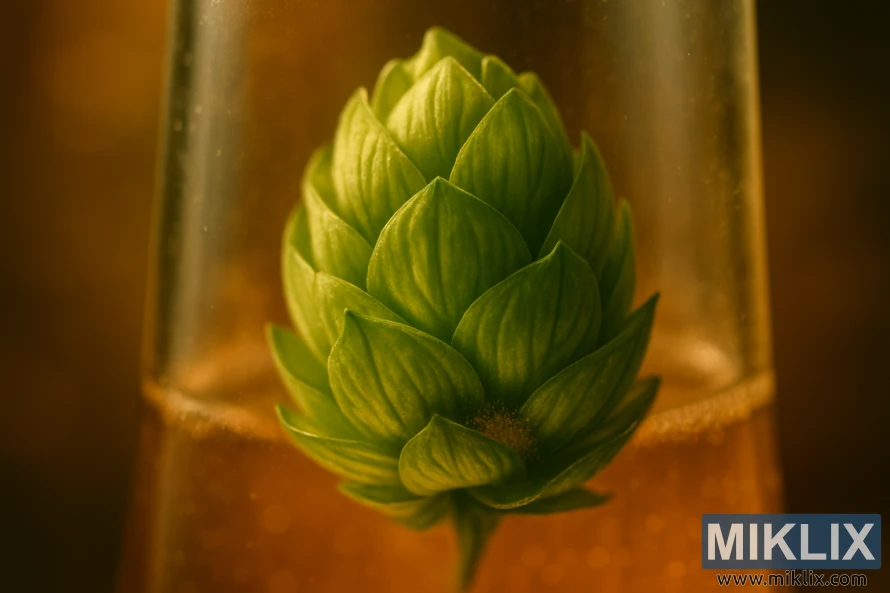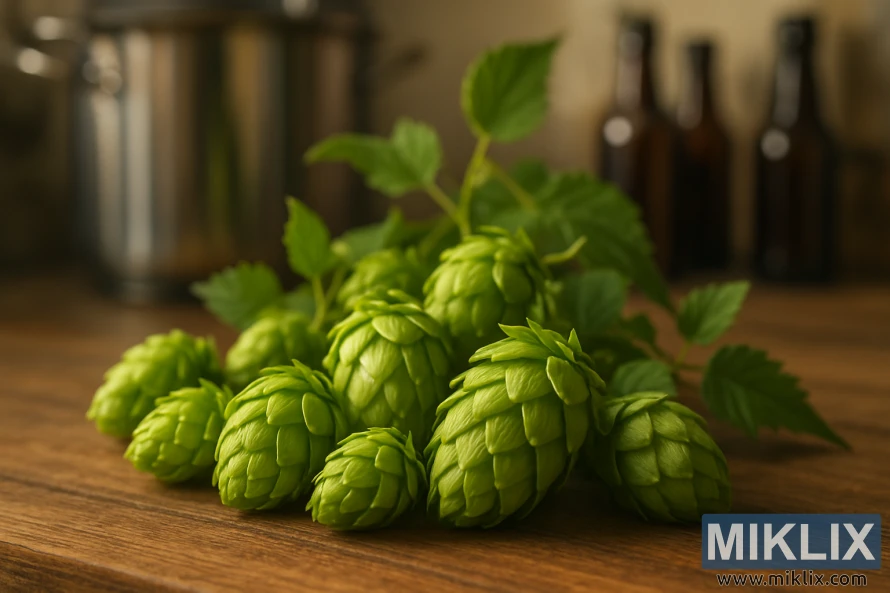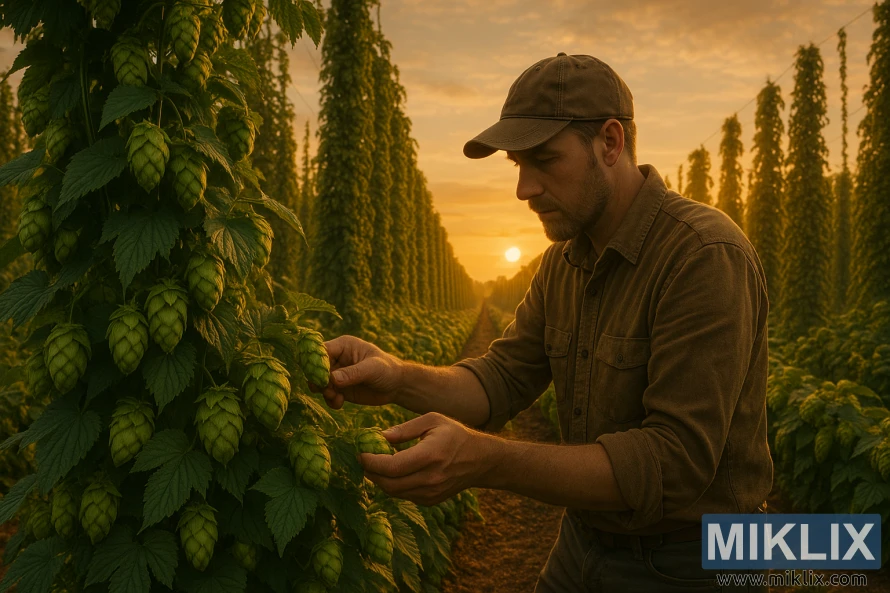Hops in Beer Brewing: Target
Published: July 27, 2025 at 8:00:30 PM UTC
Beer brewing is an art that requires a deep understanding of various ingredients and techniques. Hops, in particular, play a critical role in defining beer's flavor, aroma, and character. Target hops, bred at the Hop Research Institute at Wye College in 1971, have become increasingly popular among brewers. Originating from the United Kingdom, Target hops are renowned for their excellent disease resistance and high alpha acid content. This makes them a staple in both traditional and modern British beer styles. Their versatility has also made them a favorite in American and international craft brewing scenes.

Key Takeaways
- Target hops are a versatile variety developed in the UK in 1971.
- They are valued for their disease resistance and high alpha acid content.
- These hops are used in both traditional and modern British beer styles.
- Target hops have gained popularity in American and international craft brewing.
- Their unique characteristics make them suitable for a variety of brewing techniques.
Understanding Target Hops: Origins and Development
Target hops trace their lineage to traditional British hop varieties. They were bred for their disease resistance and high alpha acid content. This was achieved through a cross between Northern Brewer and Eastwell Golding. Their popularity among brewers grew due to their excellent characteristics.
The history of Target hops begins at the Hop Research Institute at Wye College in 1971. The breeding program aimed to merge the desirable traits of its parent hops. This resulted in a hop with high alpha acid content and robust disease resistance.
The creation of Target hops was a significant step in hop variety evolution for brewing. Key features include:
- High alpha acid content, making them ideal for bittering
- Disease resistance, reducing crop management challenges
- A unique flavor profile that complements various beer styles
Target hops were developed to meet the brewing industry's needs. They provided a reliable and high-quality hop variety. Their introduction positively impacted brewing practices, enabling brewers to craft a wide range of beer styles.
Chemical Composition and Characteristics
Understanding the chemical makeup of Target hops is key to unlocking their full brewing capabilities. These hops stand out for their high alpha acid content, ranging from 9.5% to 12.5%. This makes them a top pick for adding bitterness to a wide range of beers.
The flavor of Target hops is a mix of herbal, spice, and citrus, with notes of pine and earthiness. This distinct taste comes from the specific mix and amount of compounds in the hops.
- Alpha acids: These are responsible for the beer's bitterness, with levels between 9.5% and 12.5%.
- Beta acids: They add stability and enhance the flavor profile.
- Essential oils: These are behind the hops' aroma and taste, including herbal, spice, and citrus notes.
Target hops are perfect for beers needing a strong bitterness to balance malt sweetness. Their high alpha acid content delivers a clean, sharp bitterness. This boosts the beer's overall flavor.
In conclusion, Target hops' chemical makeup and characteristics make them a valuable addition to brewing. Their unique flavor and bittering properties help craft complex, well-balanced beers.
The Distinctive Aroma Profile of Target Hops
Target hops bring a unique mix of herbal, spice, and citrus notes to beer's aroma. Their balanced aroma makes them a top pick for brewers aiming to add depth and complexity. This blend enriches the beer's character.
Target hops are incredibly versatile in brewing. They can be added at various stages, from late additions to dry hopping. This enhances the beer's flavor and aroma. Late additions introduce a subtle yet distinct aroma. Dry hopping amplifies the beer's hop character.
Target hops aren't limited to specific beer styles. Their balanced aroma suits a wide range of beers, from pale ales to porters. By using Target hops, brewers can craft complex, nuanced beers that highlight the hop's unique traits.
- Target hops offer a harmonious blend of herbal, spice, and citrus notes.
- They are suitable for late additions and dry hopping to enhance beer's aroma.
- Their balanced aroma profile makes them versatile for various beer styles.
Understanding Target hops' unique aroma profile empowers brewers to enhance their beers' flavor and aroma. By mastering Target hops, brewers can improve their techniques. This leads to producing high-quality beers that excel in the market.

Bittering Properties and Alpha Acid Content
Target hops are celebrated for their high alpha acid content. This makes them perfect for brewers aiming to add a sharp bitterness to their beers. The alpha acids in Target hops play a key role in the beer's bittering, essential for balancing the malt's sweetness.
In brewing, the timing of hop additions is critical. Target hops are added early in the boil. This allows the alpha acids to isomerize, contributing to the beer's bitterness. The bitterness they add is clean and crisp, improving the beer's overall flavor.
Target hops' high alpha acid content also makes them efficient for brewers. Less hop material is needed to achieve the desired bitterness. This efficiency is beneficial for both cost and storage, making Target hops a practical choice for brewers of all scales.
- Key benefits of using Target hops for bittering include their high alpha acid content.
- The clean and crisp bitterness they impart to beers.
- Their efficiency in brewing, requiring less material for desired bitterness.
By understanding and utilizing the bittering properties of Target hops, brewers can craft a variety of beer styles. These beers will have balanced and refreshing flavor profiles.
Best Beer Styles for Target Hops
Target hops stand out for their balanced alpha acid content and distinct aroma. These traits make them ideal for a variety of beer styles. Brewers can explore a broad spectrum of beers with them.
Target hops are a staple in traditional English beer styles. They add a perfect balance of bitterness and subtle flavors to English pale ales and porters. For example, beers made with Target hops in English pale ales show a balanced bitterness. They also have a hint of earthy and woody notes.
Target hops are not limited to traditional styles. They also excel in modern styles like stouts and certain lagers. Their versatility allows brewers to try new techniques. This results in unique beers that showcase the hop's characteristics. Some popular styles include:
- English pale ales
- Porters
- Stouts
- Lagers
Understanding Target hops' characteristics and their interaction with brewing techniques is key. Brewers can then craft a range of beer styles. These highlight the hop's unique flavor and aroma.
Timing Your Target Hop Additions
To fully harness the essence of Target hops, brewers must meticulously plan their hop additions. These hops are ideal for a range of brewing methods, including late additions and dry hopping. Their unique traits make them versatile.
Late hop additions are a favored approach for preserving Target hops' delicate aroma compounds. By adding hops late in the boil, brewers can retain the subtle flavors and aromas. These might be lost during the boiling process.
Dry hopping is another method that benefits from Target hops. This technique involves adding hops to the beer post-fermentation. It allows the hops to infuse their flavors and aromas without the bitterness of boiling.
Here are some key considerations for timing your Target hop additions:
- For late additions, add Target hops within the last 10-15 minutes of the boil to preserve their aroma.
- For dry hopping, add Target hops during or after fermentation, depending on your specific brewing setup and desired intensity of hop flavor.
- Experiment with different hop addition times to find the optimal balance for your specific beer recipe.
The timing of hop additions greatly influences a beer's final flavor and aroma. By mastering the use of Target hops, brewers can craft complex, balanced beers. These showcase the unique qualities of this versatile hop variety.
When planning hop additions, consider the overall brewing technique and how Target hops will enhance the beer's character. Whether brewing a traditional ale or a new recipe, the right timing for Target hop additions is critical.

Storage and Handling Requirements
Understanding the right storage and handling of Target hops is key to preserving their unique qualities. Proper care ensures their quality and flavor remain intact.
Target hops, like other varieties, are sensitive to temperature, humidity, and light. Poor conditions can diminish their aroma and bittering.
To keep Target hops in top condition, brewers should adhere to these guidelines:
- Store Target hops in a cool, dry spot, away from sunlight.
- Keep the storage area at a consistent refrigerated temperature between 32°F and 40°F (0°C and 4°C).
- Low humidity is essential to prevent moisture damage.
- Use airtight containers to block air and moisture.
- Handle hops minimally to avoid damage.
By following these steps, brewers can ensure Target hops retain their quality and flavor. This is vital for effective brewing.
When handling Target hops, consider these points:
- Handle hops carefully to prevent breakage and loss of lupulin.
- Avoid heat, light, and oxygen to prevent degradation.
- Use clean tools when handling hops to prevent contamination.
By adopting these practices, brewers can fully utilize Target hops in their brewing techniques.
Commercial Brewing Applications
In the realm of large-scale brewing, Target hops stand out for their versatility and reliability. Commercial breweries have harnessed their unique traits to craft a broad spectrum of beer styles. This includes English pale ales, stouts, and porters.
Target hops are celebrated for their high alpha acid content and distinct flavor profile. Their bitterness and aroma complement a wide array of malt profiles. This makes them a favorite among commercial brewers.
The advantages of using Target hops in commercial brewing are numerous. They provide a consistent flavor and aroma, critical for large-scale brewing. Their high alpha acid content is perfect for bittering. At the same time, their flavor and aroma add depth and complexity to beers.
- Target hops are used in a variety of beer styles, including English pale ales, porters, and stouts.
- Their high alpha acid content makes them suitable for bittering, while their flavor and aroma characteristics enhance the overall character of beers.
- Commercial breweries appreciate the consistency and versatility of Target hops, making them a staple in many large-scale brewing operations.
By grasping the characteristics and applications of Target hops, commercial brewers can craft beers that highlight the hop's unique flavor and aroma. This meets the varied tastes of consumers.
Target Hops in Home Brewing
For homebrewers, Target hops are a versatile ingredient that can elevate their beers to the next level. They bring unique characteristics to the table. Target hops can be used as a single hop variety or combined with others to create complex flavor profiles.
Understanding the bittering properties and alpha acid content of Target hops is key. This knowledge helps balance the bitterness and flavor in your beers. They can be used for bittering, flavor, or aroma additions, depending on your desired outcome.
Here are some tips for using Target hops in home brewing:
- Use Target hops for bittering additions to create a balanced bitterness.
- Combine Target hops with other hop varieties to create complex flavor profiles.
- Experiment with different hop addition times to achieve the desired flavor and aroma.
By incorporating Target hops into your home brewing techniques, you can create unique and delicious beers. Whether you're a beginner or an experienced homebrewer, Target hops offer a range of possibilities for experimentation and innovation.
In conclusion, Target hops are a valuable addition to any home brewer's hop collection. They offer a range of possibilities for creating complex and balanced beers.

Pairing Target Hops with Other Varieties
Target hops offer brewers a chance to explore different hop pairings. This experimentation can enhance the character of their beers. By mixing Target hops with other varieties, brewers can craft complex, balanced flavor profiles. These profiles can elevate their beers to new heights.
When pairing Target hops with other varieties, it's important to consider their alpha acid content and aroma characteristics. For example, pairing Target hops with East Kent Goldings or Fuggles can create a balanced bitterness. It also brings out a rich, complex aroma.
Some brewers like to blend Target hops with high-alpha-acid hops like Chinook or Columbus. This combination adds a bold bitterness. Others prefer pairing Target hops with aroma hops like Hallertau or Saaz. This approach creates a more nuanced flavor profile.
- Pair Target hops with citrusy varieties like Citra or Amarillo for a refreshing twist.
- Combine Target hops with earthy hops like Willamette or Vanguard for a balanced, traditional flavor.
- Experiment with blending Target hops with spicy or floral varieties like Nelson Sauvin or Bramling Cross for unique flavor profiles.
Understanding how to pair Target hops with other varieties opens up a world of brewing possibilities. Brewers can create beers that truly stand out in the market.
Troubleshooting Common Issues
To maximize the benefits of Target hops, brewers must be aware of common problems and know how to solve them. Whether you're an experienced brewer or just starting, understanding how to address these issues can greatly improve your beer's quality.
One frequent problem is achieving a balanced bitterness. If your beer is too bitter, it might be because you added too many hops or used a variety with higher alpha acids than expected. To prevent this, always accurately measure your hops. Also, consider the alpha acid content when planning your hop additions.
Another challenge is maintaining the desired aroma. Target hops have a distinct aroma, but it can be influenced by storage conditions, when you add the hops, and your brewing techniques. Proper storage and timely addition of hops can help preserve their aroma.
- Inconsistent bitterness: Check your hop measurements and alpha acid content.
- Unwanted aroma: Verify storage conditions and hop addition timing.
- Poor hop utilization: Ensure your brewing techniques are optimized for hop utilization.
By understanding these common issues and taking steps to address them, brewers can effectively troubleshoot problems with Target hops. This way, they can create high-quality beers that highlight the unique qualities of this versatile hop variety.
Seasonal Considerations and Availability
Target hops, like many other varieties, are harvested seasonally, impacting their availability throughout the year. This seasonal production cycle requires brewers to plan their hop purchases carefully. They must stay informed about the harvest cycle to ensure a steady supply.
In the Northern Hemisphere, hop harvesting usually takes place between August and October. The timing can vary based on the region and weather. For brewers using Target hops, the best time to get fresh hops is late summer to early fall.
To maintain a consistent supply of high-quality Target hops, brewers can take several steps:
- Plan ahead: Purchase hops in advance to secure the needed quantity and quality.
- Store hops properly: Keep hops in a cool, dry place to preserve their flavor and aroma.
- Consider contract brewing or partnerships: Collaborating with other breweries or negotiating contracts with hop suppliers can help stabilize hop availability.
By understanding the seasonal availability of Target hops and adopting strategic planning, brewers can maintain a consistent supply. This ensures they can continue producing high-quality beers.

Cost Analysis and Economic Factors
Understanding the economic implications of using Target hops is essential for brewers. The cost of hops can significantly affect the overall production cost of beer.
When conducting a cost analysis, brewers should consider several factors. These include the price per pound of Target hops, the amount used in brewing, and the frequency of purchases. Here are key considerations:
- The alpha acid content and its impact on bittering efficiency
- The storage and handling costs associated with maintaining hop quality
- The economic implications of waste
- The impact of market fluctuations on hop pricing
Economic factors also play a role in deciding when and how to use Target hops. For instance, brewers might choose to use Target hops for bittering. This is because of their high alpha acid content. This could potentially reduce the overall amount needed and the cost.
- Monitor market trends for hop prices
- Consider contract purchasing to stabilize costs
- Optimize hop usage through efficient brewing techniques
- Evaluate the cost-effectiveness of different hop varieties
By carefully analyzing these economic factors and adjusting their brewing practices, brewers can maximize the value of their hop purchases. This helps them maintain a competitive edge in the market.
Sustainability and Environmental Impact
## Sustainability and Environmental Impact
The environmental footprint of hop farming, with a focus on Target hops, is a pressing concern for brewers. As the need for sustainable brewing grows, understanding the ecological effects of hop cultivation is vital.
Target hops, like other agricultural products, leave an environmental mark. This includes water usage, land use, and the use of pesticides and fertilizers. Yet, there are several strategies brewers can use to lessen these impacts.
- Choosing hop suppliers who employ sustainable farming practices.
- Reducing waste by using all parts of the hop plant.
- Implementing energy-efficient brewing processes.
- Supporting local hop farming to reduce transportation emissions.
Advances in agricultural technology and farming methods are making hop cultivation more sustainable. These include better irrigation systems, integrated pest management, and disease-resistant hop varieties.
By embracing these sustainable practices and backing environmentally friendly hop farming, brewers can greatly reduce their ecological footprint. This not only helps the environment but also boosts the brewery's sustainability and reputation.
Conclusion
Mastering Target hops is essential for improving your brewing skills. Knowing their origins, chemical makeup, and characteristics is key. This knowledge helps brewers craft complex, balanced beers.
Using Target hops effectively goes beyond their bittering and alpha acid content. It's about timing, storage, and handling to keep their distinct aroma. This ensures the hops' unique flavor is preserved in your beer.
Whether you brew commercially or at home, Target hops can take your beers to new levels. By combining them with other hops and considering seasonal availability, you can create unique brews. This approach allows for a wide range of flavors and aromas in your beers.
As you continue to experiment with Target hops, remember that brewing is a continuous learning process. Stay updated on hop cultivation and brewing trends. This will help you stay at the forefront of craft brewing.
Further Reading
If you enjoyed this post, you may also like these suggestions:
